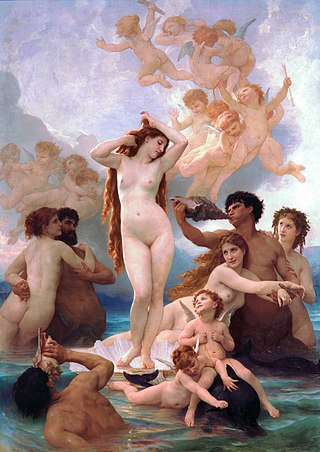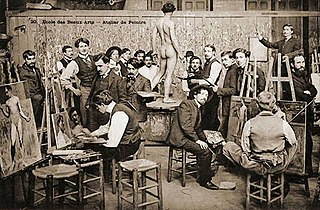
Thomas Cowperthwait Eakins was an American realist painter, photographer, sculptor, and fine arts educator. He is widely acknowledged to be one of the most important American artists.

Academic art, or academicism or academism, is a style of painting and sculpture produced under the influence of European academies of art. Specifically, academic art is the art and artists influenced by the standards of the French Académie des Beaux-Arts, which was practiced under the movements of Neoclassicism and Romanticism, and the art that followed these two movements in the attempt to synthesize both of their styles, and which is best reflected by the paintings of William-Adolphe Bouguereau, Thomas Couture, and Hans Makart. In this context it is often called "academism", "academicism", "art pompier" (pejoratively), and "eclecticism", and sometimes linked with "historicism" and "syncretism." Academic art is closely related to Beaux-Arts architecture, which developed in the same place and holds to a similar classicizing ideal.
The Minneapolis College of Art and Design (MCAD) is a private college specializing in the visual arts and located in Minneapolis, Minnesota. MCAD currently enrolls approximately 800 students. MCAD is one of just a few major art schools to offer a major in comic art.

Visual arts education is the area of learning that is based upon the kind of art that one can see, visual arts—drawing, painting, sculpture, printmaking, and design in jewelry, pottery, weaving, fabrics, etc. and design applied to more practical fields such as commercial graphics and home furnishings. Contemporary topics include photography, video, film, design, and computer art. Art education may focus on students creating art, on learning to criticize or appreciate art, or some combination of the two.
Zora Petrović was a Serbian painter. Her notable works can be seen in the Museum of Contemporary Art in Belgrade, and in Pavle Beljanski Memorial Collection in Novi Sad.

Hans Fredrik Gude was a Norwegian romanticist painter and is considered along with Johan Christian Dahl to be one of Norway's foremost landscape painters. He has been called a mainstay of Norwegian National Romanticism. He is associated with the Düsseldorf school of painting.

Robert Hale Ives Gammell was an American artist best known for his sequence of paintings based on Francis Thompson's poem "The Hound of Heaven". Gammell painted symbolic images that reflected his study of literature, mythology, psychology, and religion.
John Wilde was a painter, draughtsman and printmaker of fantastic imagery. Born near Milwaukee, Wilde lived most of his life in Wisconsin, save for service in the U.S. Army during World War II. He received bachelor and master degrees in art from the University of Wisconsin–Madison, where he taught for some 35 years. Wilde was associated with the Magic Realism movement and Surrealism in the United States. His darkly humorous figurative imagery often included self-portraits through which he interacted with the people, animals and surreal objects that populate his fantasy world.

An atelier is the private workshop or studio of a professional artist in the fine or decorative arts or an architect, where a principal master and a number of assistants, students, and apprentices can work together producing fine art or visual art released under the master's name or supervision.

The Charles H. Cecil Studios is a private atelier in Florence, Italy. It is run by American painter and art historian Charles H. Cecil, who was trained by R. H. Ives Gammell. It offers training in classical techniques of drawing and oil painting. Charles H. Cecil Studios occupies the most historic Florentine atelier still in active use.

Classical Realism is an artistic movement in the late-20th and early 21st century in which drawing and painting place a high value upon skill and beauty, combining elements of 19th-century neoclassicism and realism.

Jacob Collins is an American realist painter working in New York City. He is a leading figure of the contemporary classical art revival.
Jesús Guerrero Galván was a Mexican artist, a member of the Mexican muralism movement of the early 20th century. He began his career in Guadalajara but moved to Mexico City to work on mural projects in the 1930s for the Secretaría de Educación Pública and Comisión Federal de Electricidad In addition, he did easel paintings, with major exhibitions in the United States and Mexico. In 1943, he was an artist-in-residence for the University of New Mexico, painting the mural Union of the Americas Joined in Freedom, considered to be one of his major works. Guerrero Galván was accepted as a member of the Salón de la Plástica Mexicana.

The Boston School was a group of Boston-based painters active in the first three decades of the twentieth century. Often classified as American Impressionists, they had their own regional style, combining the painterliness of Impressionism with a more conservative approach to figure painting and a marked respect for the traditions of Western art history. Their preferred subject matter was genteel: portraits, picturesque landscapes, and young women posing in well-appointed interiors. Major influences included John Singer Sargent, Claude Monet, and Jan Vermeer. Key figures in the Boston School were Edmund C. Tarbell, Frank Weston Benson, and William McGregor Paxton, all of whom trained in Paris at the Académie Julian and later taught at the School of the Museum of Fine Arts. Their influence can still be seen in the work of some contemporary Boston-area artists.

John Nelson Shanks was an American artist and painter. His best known works include his portrait of Diana, Princess of Wales, first shown at Hirschl & Adler Gallery in New York City, April 24 to June 28, 1996 and the portrait of president Bill Clinton for the National Portrait Gallery.
Arny Karl was one of the key artists in the early stages of the California Plein-Air Revival, which started in the 1980s and continues to this day. Along with Tim Solliday and Peter Seitz Adams, Karl helped revitalize the use of pastels to paint outdoors or en plein air, as the French described regarding the practice of working directly from nature. Karl was a student of Theodore Lukits (1897–1992), who was a prominent California Impressionist and the best known Early California painter to have worked in pastel. His work has been included in a number of museum exhibitions, is represented in a number of prominent public and private collections and has been the subject of a number of curatorial essays.
Peter Seitz Adams is an American artist. His body of work focuses on landscapes and seascapes created en plein air in oil or pastel as well as enigmatic figure and still-life paintings. He is noted for his colorful, high-key palette and broad brushwork. Adams has held numerous solo and group exhibitions in galleries and museums, including throughout California, the Western United States, and on the East Coast in Philadelphia, Vermont, and New York. Adams is the longest serving President of the California Art Club and has served on its board of directors in Pasadena, California from 1993 to 2018. He is also a writer on subjects relating to historic artists for the California Art Club Newsletter, as well as for a number of the organization's exhibition catalogs.
Anthony Benjamin FRSA, RE was an English painter, sculptor and printmaker. Referred to as a 'polymathic artist' by critic Rosemary Simmons when writing about his work for the Borderline Images By Anthony Benjamin show at The Graffiti Gallery in 1979.

Henri Bernard Goetz was a French American surrealist painter and engraver. He is known for his artwork, as well as for inventing the carborundum printmaking process. His work is represented in more than 100 galleries worldwide.

Richard Frederick Lack was an American artist, educator, and writer. He is known for his work in all major genres of traditional art. He founded Atelier Lack in 1969 to train students interested in learning the skills necessary to create fine representational art, and he initiated the use of the term “Classical Realism” as an artistic designation. He trained thirty-one artists who taught or opened ateliers.

















